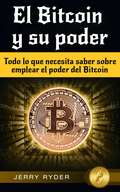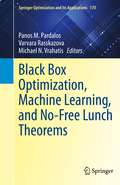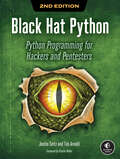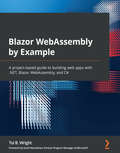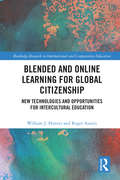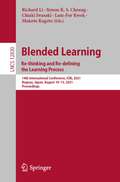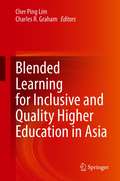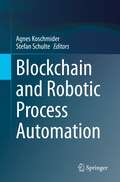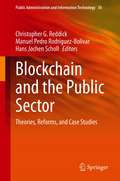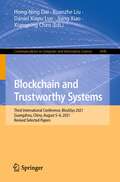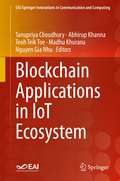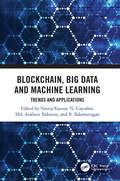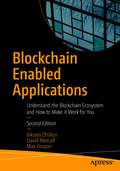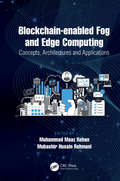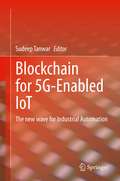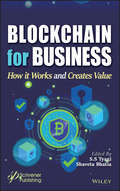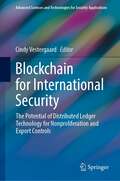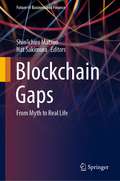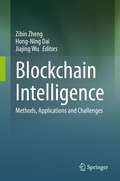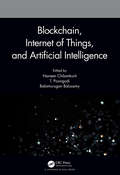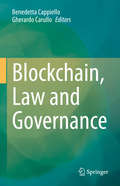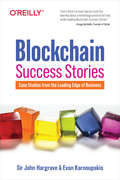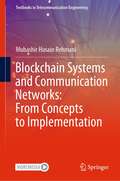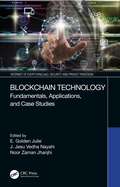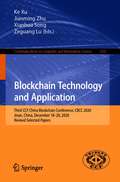- Table View
- List View
El Bitcoin y su poder: Todo lo que necesita saber sobre emplear el poder del Bitcoin
by Jerry RyderEl Bitcoin se está apoderando del mundo. Esta moneda digital es completamente diferente a todo lo que haya visto en el pasado, lo que la hace novedosa y excitante. También tiene varios beneficios, como ser: La capacidad de poder enviar dinero a cualquier parte del mundo con bajas tasas por transacción Mantener su información personal segura y protegida No tener que lidiar con la intervención del gobierno Ahora es el momento de empezar con el Bitcoin, el juego de la criptomoneda. Todos saben que el conocimiento es poder. En este libro aprenderá sobre: Que es el Bitcoin realmente Todos los modos en que puede usar el Bitcoin para beneficio personal Cómo comenzar La tecnología atrás del Bitcoin Lo que la moneda digital puede hacer por usted Pros y contras de utilizar monedas digitales Mejores estrategias de inversión Cómo hacer dinero con el Bitcoin Y ¡mucho más! ¡No espere más! Haga click en el botón de comprar ahora y obtenga “Bitcoin y su poder” hoy mismo, y ¡comience a obtener dinero!
Black Box Optimization, Machine Learning, and No-Free Lunch Theorems (Springer Optimization and Its Applications #170)
by Panos M. Pardalos Varvara Rasskazova Michael N. VrahatisThis edited volume illustrates the connections between machine learning techniques, black box optimization, and no-free lunch theorems. Each of the thirteen contributions focuses on the commonality and interdisciplinary concepts as well as the fundamentals needed to fully comprehend the impact of individual applications and problems. Current theoretical, algorithmic, and practical methods used are provided to stimulate a new effort towards innovative and efficient solutions. The book is intended for beginners who wish to achieve a broad overview of optimization methods and also for more experienced researchers as well as researchers in mathematics, optimization, operations research, quantitative logistics, data analysis, and statistics, who will benefit from access to a quick reference to key topics and methods. The coverage ranges from mathematically rigorous methods to heuristic and evolutionary approaches in an attempt to equip the reader with different viewpoints of the same problem.
Black Hat Python, 2nd Edition: Python Programming for Hackers and Pentesters
by Tim Arnold Justin SeitzFully-updated for Python 3, the second edition of this worldwide bestseller (over 100,000 copies sold) explores the stealthier side of programming and brings you all new strategies for your hacking projects.When it comes to creating powerful and effective hacking tools, Python is the language of choice for most security analysts. In Black Hat Python, 2nd Edition, you&’ll explore the darker side of Python&’s capabilities—writing network sniffers, stealing email credentials, brute forcing directories, crafting mutation fuzzers, infecting virtual machines, creating stealthy trojans, and more. The second edition of this bestselling hacking book contains code updated for the latest version of Python 3, as well as new techniques that reflect current industry best practices. You&’ll also find expanded explanations of Python libraries such as ctypes, struct, lxml, and BeautifulSoup, and dig deeper into strategies, from splitting bytes to leveraging computer-vision libraries, that you can apply to future hacking projects. You&’ll learn how to: • Create a trojan command-and-control using GitHub • Detect sandboxing and automate common malware tasks, like keylogging and screenshotting • Escalate Windows privileges with creative process control • Use offensive memory forensics tricks to retrieve password hashes and inject shellcode into a virtual machine • Extend the popular Burp Suite web-hacking tool • Abuse Windows COM automation to perform a man-in-the-browser attack • Exfiltrate data from a network most sneakily When it comes to offensive security, your ability to create powerful tools on the fly is indispensable. Learn how with the second edition of Black Hat Python. New to this edition:All Python code has been updated to cover Python 3 and includes updated libraries used in current Python applications. Additionally, there are more in-depth explanations of the code and the programming techniques have been updated to current, common tactics. Examples of new material that you'll learn include how to sniff network traffic, evade anti-virus software, brute-force web applications, and set up a command-and-control (C2) system using GitHub.
Blazor WebAssembly by Example: A project-based guide to building web apps with .NET, Blazor WebAssembly, and C#
by Scott Hanselman Toi B. WrightDiscover blueprints that explore various components of Blazor, C#, and .NET to help you build web apps without learning JavaScriptKey FeaturesExplore complete, easy-to-follow web projects using BlazorBuild projects such as a weather app, expense tracker, and Kanban board with real-world applicationsUnderstand and work with Blazor WebAssembly effectively without spending too much time focusing on the theoryBook DescriptionBlazor WebAssembly makes it possible to run C# code on the browser instead of having to use JavaScript, and does not rely on plugins or add-ons. The only technical requirement for using Blazor WebAssembly is a browser that supports WebAssembly, which, as of today, all modern browsers do. Blazor WebAssembly by Example is a project-based guide for learning how to build single-page web applications using the Blazor WebAssembly framework. This book emphasizes the practical over the theoretical by providing detailed step-by-step instructions for each project. You'll start by building simple standalone web applications and progress to developing more advanced hosted web applications with SQL Server backends. Each project covers a different aspect of the Blazor WebAssembly ecosystem, such as Razor components, JavaScript interop, event handling, application state, and dependency injection. The book is designed in such a way that you can complete the projects in any order. By the end of this book, you will have experience building a wide variety of single-page web applications with .NET, Blazor WebAssembly, and C#.What you will learnDiscover the power of the C# language for both server-side and client-side web developmentUse the Blazor WebAssembly App project template to build your first Blazor WebAssembly applicationUse templated components and the Razor class library to build and share a modal dialog boxUnderstand how to use JavaScript with Blazor WebAssemblyBuild a progressive web app (PWA) to enable native app-like performance and speedUnderstand dependency injection (DI) in .NET to build a shopping cart appGet to grips with .NET Web APIs by building a task manager appWho this book is forThis book is for .NET web developers who are tired of constantly learning new JavaScript frameworks and wish to write web applications using Blazor WebAssembly, leveraging the power of .NET and C#. The book assumes beginner-level knowledge of the C# language, .NET framework, Microsoft Visual Studio, and web development concepts.
Blended and Online Learning for Global Citizenship: New Technologies and Opportunities for Intercultural Education (Routledge Research in International and Comparative Education)
by Roger Austin William J. HunterBy showcasing international, European, and community-based projects, this volume explores how online technologies and collaborative and blended learning can be used to bolster social cohesion and increase students’ understanding of what it means to be a global citizen. With the pace of technology rapidly increasing, Blended and Online Learning for Global Citizenship draws timely attention to the global lessons being learned from the impact of these technologies on peace building, community development, and acceptance of difference. In-depth case studies showcasing successful projects in Europe, Northern Ireland, and Israel explore blended learning and illustrate how schools and educators have embraced online technologies to foster national and international links both within and beyond communities. This has, in turn, equipped students with experiences that have informed their attitudes to cultural and political conflicts, as well as racial, ethnic, and social diversity. Building on the authors’ previous work Online Learning and Community Cohesion (2013), this thought-provoking text will be of interest to researchers, academics, and postgraduate students in the fields of international and comparative education. Educators and school leaders concerned with how multiculturalism and technology play out in the classroom environment will also benefit from reading this text.
Blended Learning: 14th International Conference, ICBL 2021, Nagoya, Japan, August 10–13, 2021, Proceedings (Lecture Notes in Computer Science #12830)
by Richard Li Simon K. S. Cheung Chiaki Iwasaki Lam-For Kwok Makoto KagetoThis book constitutes the refereed proceedings of the 14th International Conference on Blended Learning, ICBL 2021, held online in August 2021. The 30 papers, including 4 keynote papers, were carefully reviewed and selected from 79 submissions. The conference theme of ICBL 2021 is Blended Learning: Re-thinking and Re-defining the Learning Process. The papers are organized in topical sections named: content and instructional design; enriched and smart learning experience; experience in blended learning; institutional policies and strategies; and online and collaborative learning.
Blended Learning for Inclusive and Quality Higher Education in Asia
by Charles R. Graham Cher Ping LimThis book demonstrates how blended learning improves access to and enhances the quality of higher education teaching and learning in Asian universities. It first discusses how leading universities in the region drive and support blended learning at the institutional level to enhance student learning engagement and outcomes. It then examines 10 effective implementations and lessons learned of blended learning practices across different disciplinary courses and programmes (humanities and language, science and engineering, social science and education, and others) in the region. The chapters in this book provide an overview of the opportunities and challenges of blended learning for improved access and enhanced quality of higher education, and offer insights into the promising blended learning policies and practices in Asian universities.
Blockchain and Robotic Process Automation
by Agnes Koschmider Stefan SchulteThis book integrates the material of the lecture series “Blockchain and Robotic Process Automation”, offered at Kiel University. The lecture series sheds light on current research topics on blockchain and robotic process automation (RPA) also in combination with business process management (BPM) or process mining. In this series, leading scientists and business experts give insights into the use of the blockchain technology and RPA. The seven contributions included offer a general introduction into blockchain and smart contracts, and detail the extraction of meaningful events for process mining from blockchain, challenges of blockchain-based collaborative business processes, executing Decision Model and Notation decisions on the blockchain, a blockchain-based solution for digital payment, blockchain use cases in transportation and logistics, and automatically identifying process automation candidates using natural language processing. Overall, the book provides researchers and graduate students with a basic introduction into blockchain, its applications, useful combinations of BPM and blockchain, and use cases for RPA.
Blockchain and the Public Sector: Theories, Reforms, and Case Studies (Public Administration and Information Technology #36)
by Christopher G. Reddick Manuel Pedro Rodríguez-Bolívar Hans Jochen SchollThis book discusses blockchain technology and its potential applications in digital government and the public sector. With its robust infrastructure and append-only record system, blockchain technology is being increasingly employed in the public sector, specifically where trustworthiness and security are of importance. Written by leading scholars and practitioners, this edited volume presents challenges, benefits, regulations, frameworks, taxonomies, and applications of blockchain technology in the public domain.Specifically, the book analyzes the implementation of blockchain technologies in the public sector and the potential reforms it would bring. It discusses emerging technologies and their role in the implementation of blockchain technologies in the public sector. The book details the role of blockchain in the creation of public value in the delivery of public sector services. The book analyzes effects, impacts, and outcomes from the implementation of blockchain technologies in the public sector in select case studies.Providing up-to-date information on important developments regarding blockchain in government around the world, this volume will appeal to academics, researchers, policy-makers, public managers, international organizations, and technical experts looking to understand how blockchain can enhance public service delivery.
Blockchain and Trustworthy Systems: Third International Conference, BlockSys 2021, Guangzhou, China, August 5–6, 2021, Revised Selected Papers (Communications in Computer and Information Science #1490)
by Hong-Ning Dai Xuanzhe Liu Daniel Xiapu Luo Jiang Xiao Xiangping ChenThis book constitutes the thoroughly refereed post conference papers of the Third International Conference on Blockchain and Trustworthy Systems, Blocksys 2021, held in Guangzhou, China, in August 2021.*The 38 full papers and the 12 short papers were carefully reviewed and selected from 98 submissions. The papers are organized in topical sections: Contents Blockchain and Data Mining; Performance Optimization of Blockchain; Blockchain Security and Privacy; Theories and Algorithms for Blockchain; Blockchain and Internet of Things; Blockchain and Smart Contracts; Blockchain Services and Applications; Trustworthy System Development.*
Blockchain Applications in IoT Ecosystem (EAI/Springer Innovations in Communication and Computing)
by Tanupriya Choudhury Abhirup Khanna Teoh Teik Toe Madhu Khurana Nguyen Gia NhuThis book focuses on the fundamentals of blockchain technology along with the means and methods of its integration with Internet of Things (IoT). The book allows the reader to have a deeper understanding of blockchain technology, IoT and various application areas wherein both technologies can be implemented. The book serves the purpose of providing knowledge about the fundamentals of blockchain and IoT to a common reader along with allowing a research scholar to identify some futuristic problem areas that emerge from the convergence of both technologies. Furthermore, the authors discuss relevant application areas such as smart city, e-healthcare, smart travel, etc. throughout the course of the book. The book also talks through a few case studies illustrating the implementation and benefits of using blockchain and IoT. Provides a comprehensive view of blockchain technology and its integration with IoT;Facilitates in having a valuable understanding of various application areas pertaining to blockchain and IoT;Assists the reader in exploring new research areas wherein blockchain and IoT can find their applicability based upon their list of benefits.
Blockchain, Big Data and Machine Learning: Trends and Applications
by Neeraj Kumar; N. Gayathri; Md. Arafatur Rahman; B. BalamuruganPresent book covers new paradigms in Blockchain, Big Data and Machine Learning concepts including applications and case studies. It explains dead fusion in realizing the privacy and security of blockchain based data analytic environment. Recent research of security based on big data, blockchain and machine learning has been explained through actual work by practitioners and researchers, including their technical evaluation and comparison with existing technologies. The theoretical background and experimental case studies related to real-time environment are covered as well. Aimed at Senior undergraduate students, researchers and professionals in computer science and engineering and electrical engineering, this book: Converges Blockchain, Big Data and Machine learning in one volume. Connects Blockchain technologies with the data centric applications such Big data and E-Health. Easy to understand examples on how to create your own blockchain supported by case studies of blockchain in different industries. Covers big data analytics examples using R. Includes lllustrative examples in python for blockchain creation.
Blockchain Enabled Applications: Understand the Blockchain Ecosystem and How to Make it Work for You
by Vikram Dhillon David Metcalf Max HooperLearn all about blockchain and its applications in cryptocurrency, healthcare, Internet of Things, finance, decentralized organizations, and more. Featuring case studies and practical insights, this book covers a unique mix of topics and offers insight into how to overcome hurdles that arise as the market and consumers grow accustomed to blockchain-based organizations and services. The book is divided into three major sections. The first section provides a historical background to blockchain technology. You will start with a historical context to financial capital markets when Bitcoin was invented, followed by mining protocols, the need for consensus, hardware mining, etc. Next, a formal introduction to blockchain is provided covering transaction workflow, role of decentralized network, and payment verification. Then, we dive deep into a different implementation of a blockchain: Ethereum. The main technical features, such as Ethereum Virtual Machine, are presented along with the smart contract programming language, Solidity. In this second section, you will look at some modern use cases for blockchain from a decentralized autonomous organization, high-performance computing in Ethereum and off-grid computations, and healthcare and scientific discovery. The final section of the book looks toward the future of blockchain. This is followed by chapters covering the rise of consortia in the blockchain world, the Hyperledger project, particularly the updates since 2018, and a chapter on educational blockchain games. This is followed by updates to EOS.IO, Chain Core, and Quorum, ICOs and a look at the major changes to financial markets brought about by blockchain and decentralized networks. What You Will Learn Get an overview of the popular games employed to teach the basic concepts of blockchain and decentralized networksBe familiar with the rise of blockchain consortiums as well as updates to Hyperledger Project, 2020Find out about cloud blockchains, including Microsoft Azure and Amazon Webservices, and how to set up test environmentsStudy machine learning integration in the blockchain and the role of smart contracts Who This Book Is For Blockchain developers interested in keeping up with the newest updates and students looking for a broad overview of this vast ecosystem, plus business executives who want to make informed product decisions about including blockchain as well as policy makers who want a better understanding of the current use cases
Blockchain-enabled Fog and Edge Computing: Concepts, Architectures and Applications
by Mubashir Husain Rehmani Muhammad Maaz RehanThis comprehensive book unveils the working relationship of blockchain and the fog/edge computing. The contents of the book have been designed in such a way that the reader will not only understand blockchain and fog/edge computing but will also understand their co-existence and their collaborative power to solve a range of versatile problems. The first part of the book covers fundamental concepts and the applications of blockchain-enabled fog and edge computing. These include: Internet of Things, Tactile Internet, Smart City; and E-challan in the Internet of Vehicles. The second part of the book covers security and privacy related issues of blockchain-enabled fog and edge computing. These include, hardware primitive based Physical Unclonable Functions; Secure Management Systems; security of Edge and Cloud in the presence of blockchain; secure storage in fog using blockchain; and using differential privacy for edge-based Smart Grid over blockchain. This book is written for students, computer scientists, researchers and developers, who wish to work in the domain of blockchain and fog/edge computing. One of the unique features of this book is highlighting the issues, challenges, and future research directions associated with Blockchain-enabled fog and edge computing paradigm. We hope the readers will consider this book a valuable addition in the domain of Blockchain and fog/edge computing.
Blockchain for 5G-Enabled IoT: The new wave for Industrial Automation
by Sudeep TanwarThis book addresses one of the most overlooked practical, methodological, and moral questions in the journey to secure and handle the massive amount of data being generated from smart devices interactions: the integration of Blockchain with 5G-enabled IoT. After an overview, this book discusses open issues and challenges, which may hinder the growth of Blockchain technology. Then, this book presents a variety of perspectives on the most pressing questions in the field, such as: how IoT can connect billions of objects together; how the access control mechanisms in 5G-enabled industrial environment works; how to address the real-time and quality-of-service requirements for industrial applications; and how to ensure scalability and computing efficiency. Also, it includes a detailed discussions on the complexity of adoption of Blockchain for 5G-Enabled IoT and presents comparative case studies with respect to various performance evaluation metrics such as scalability, data management, standardization, interoperability and regulations, accessibility, human-factors engineering and interfaces, reliability, heterogeneity, and QoS requirements. This book acts as a professional guide for the practitioners in information security and related topics.
Blockchain for Business: How it Works and Creates Value
by S. S. Tyagi Shaveta BhatiaThe book focuses on the power of business blockchain. It gives an overview of blockchain in traditional business, marketing, accounting and business intelligence. The book provides a detailed working knowedge of blockchain, user cases of blockchain in business, cryptocurrency and Initial Coin Offering(ICO) along with the risks associated with them. The book also covers the detailed study of decentralization, mining, consensus, smart contracts, concepts and working of distributed ledgers and hyper ledgers as well as many other important concepts. It also details the security and privacy aspects of blockchain. The book is beneficial for readers who are preparing for their business careers, those who are working with small scale businesses and startups, and helpful for business executives, managers, entrepreneurs, bankers, government officials and legal professionals who are looking to blockchain for secure financial transactions. The book will also be beneficial for researchers and students who want to study the latest developments of blockchain.
Blockchain for International Security: The Potential of Distributed Ledger Technology for Nonproliferation and Export Controls (Advanced Sciences and Technologies for Security Applications)
by Cindy VestergaardThis book intersects the distributed ledger technology (DLT) community with the international security community. Given the increasing application of blockchain technology in the fields of business and international development, there is a growing body of study on other use cases. For instance, can blockchain have a significant role in preserving and improving international security? This book explores this question in the context of preventing the proliferation of some of the most dangerous materials in the world—items that if not secured can lend to the development of weapons of mass destruction. It considers how blockchain can increase efficiencies in the global trade of nuclear and chemical materials and technology, thereby increasing assurances related to compliance with international nonproliferation and disarmament treaties.
Blockchain Gaps: From Myth to Real Life (Future of Business and Finance)
by Shin’ichiro Matsuo Nat SakimuraThis book analyzes the fundamental issues faced when blockchain technology is applied to real-life applications. These concerns, not only in the realm of computer science, are caused by the nature of technological design. Blockchain is considered the foundation of a wide range of flexible ecosystems; its technology is an excellent mixture of mathematics, cryptography, incentive mechanisms, economics, and pertinent regulations. The book provides an essential understanding of why such fundamental issues arise, by revising the underlying theories. Blockchain theory is thus presented in an easy-to-understand, useful manner. Also explained is the reason why blockchain is hard to adopt for real-life problems but is valuable as a foundation for flexible ecosystems. Included are directions for solving those problems and finding suitable areas for blockchain applications in the future. The authors of this work are experts from a wide range of backgrounds such as cryptography, distributed computing, computer science, trust, identity, regulation, and standardization. Their contributions collected here will appeal to all who are interested in blockchain and the elements surrounding it.
Blockchain Intelligence: Methods, Applications and Challenges
by Zibin Zheng Hong-Ning Dai Jiajing WuThis book focuses on using artificial intelligence (AI) to improve blockchain ecosystems. Gathering the latest advances resulting from AI in blockchain data analytics, it also presents big data research on blockchain systems.Despite blockchain's merits of decentralisation, immutability, non-repudiation and traceability, the development of blockchain technology has faced a number of challenges, such as the difficulty of data analytics on encrypted blockchain data, poor scalability, software vulnerabilities, and the scarcity of appropriate incentive mechanisms. Combining AI with blockchain has the potential to overcome the limitations, and machine learning-based approaches may help to analyse blockchain data and to identify misbehaviours in blockchain. In addition, deep reinforcement learning methods can be used to improve the reliability of blockchain systems.This book focuses in the use of AI to improve blockchain systems and promote blockchain intelligence. It describes data extraction, exploration and analytics on representative blockchain systems such as Bitcoin and Ethereum. It also includes data analytics on smart contracts, misbehaviour detection on blockchain data, and market analysis of blockchain-based cryptocurrencies. As such, this book provides researchers and practitioners alike with valuable insights into big data analysis of blockchain data, AI-enabled blockchain systems, and applications driven by blockchain intelligence.
Blockchain, Internet of Things, and Artificial Intelligence
by Naveen Chilamkurti T. Poongodi Balamurugan BalusamyBlockchain, Internet of Things, and Artificial Intelligence provides an integrated overview and technical description of the fundamental concepts of blockchain, IoT, and AI technologies. State-of-the-art techniques are explored in depth to discuss the challenges in each domain. The convergence of these revolutionized technologies has leveraged several areas that receive attention from academicians and industry professionals, which in turn promotes the book's accessibility more extensively. Discussions about an integrated perspective on the influence of blockchain, IoT, and AI for smart cities, healthcare, and other business sectors illuminate the benefits and opportunities in the ecosystems worldwide. The contributors have focused on real-world examples and applications and highlighted the significance of the strengths of blockchain to transform the readers’ thinking toward finding potential solutions. The faster maturity and stability of blockchain is the key differentiator in artificial intelligence and the Internet of Things. This book discusses their potent combination in realizing intelligent systems, services, and environments. The contributors present their technical evaluations and comparisons with existing technologies. Theoretical explanations and experimental case studies related to real-time scenarios are also discussed. FEATURES Discusses the potential of blockchain to significantly increase data while boosting accuracy and integrity in IoT-generated data and AI-processed information Elucidates definitions, concepts, theories, and assumptions involved in smart contracts and distributed ledgers related to IoT systems and AI approaches Offers real-world uses of blockchain technologies in different IoT systems and further studies its influence in supply chains and logistics, the automotive industry, smart homes, the pharmaceutical industry, agriculture, and other areas Presents readers with ways of employing blockchain in IoT and AI, helping them to understand what they can and cannot do with blockchain Provides readers with an awareness of how industry can avoid some of the pitfalls of traditional data-sharing strategies This book is suitable for graduates, academics, researchers, IT professionals, and industry experts.
Blockchain, Law and Governance
by Benedetta Cappiello Gherardo CarulloThis volume explores from a legal perspective, how blockchain works. Perhaps more than ever before, this new technology requires us to take a multidisciplinary approach. The contributing authors, which include distinguished academics, public officials from important national authorities, and market operators, discuss and demonstrate how this technology can be a driver of innovation and yield positive effects in our societies, legal systems and economic/financial system. In particular, they present critical analyses of the potential benefits and legal risks of distributed ledger technology, while also assessing the opportunities offered by blockchain, and possible modes of regulating it. Accordingly, the discussions chiefly focus on the law and governance of blockchain, and thus on the paradigm shift that this technology can bring about.
Blockchain Success Stories
by Sir John Hargrave Evan KarnoupakisAccessible and fun to read, this practical book contains a collection of stories of organizations using blockchain technology in practice. Through deep research and firsthand interviews, authors Sir John Hargrave and Evan Karnoupakis show you how leading-edge organizations have worked to integrate blockchain into their businesses.You'll start by exploring the origins of blockchain, with plain-English descriptions of industry terminology like bitcoin, cryptocurrencies, and smart contracts. Then you'll dive into 10 story-driven case studies that will teach you easy-to-understand blockchain best practices.Explore real-life examples of companies developing and integrating blockchain applications for mobile voting, credentialing, supply chains, and a $100 million virtual cat collectible marketplaceDiscover how blockchain is transforming industries like banking, communications, government, logistics, and nonprofitsLearn about engaging blockchain success stories, such as Binance, Ethereum, and CircleExamine common blockchain best practices, with illustrations for easy reference, and learn how to apply them in your business, government project, or charitable foundation
Blockchain Systems and Communication Networks: From Concepts to Implementation (Textbooks in Telecommunication Engineering)
by Mubashir Husain RehmaniThis book provides extensive insights on blockchain systems, starting from a historical perspective and moving towards building foundational knowledge, with focus on communication networks. It covers blockchain applications, algorithms, architectures, design and implementation, and security and privacy issues, providing the reader with a comprehensive overview. Further, it discusses blockchain systems and its integration to communication networks. The book includes hands-on, practical tutorials, self-assessment exercises, and review questions; tips and sample programs are also provided throughout. Complementary supporting material for instructors, including open source programming code for practical tutorials and exercises, is also available. The target audience includes graduate students, professionals, and researchers working in the areas of blockchain systems, distributed ledger technology, computer networks and communications, artificial intelligence, and cybersecurity.
Blockchain Technology: Fundamentals, Applications, and Case Studies (Internet of Everything (IoE))
by E. Golden Julie, J. Jesu Vedha Nayahi, and Noor Zaman JhanjhiThis book presents a detailed exploration of adaption and implementation, as well as a 360-degree view spectrum of blockchain technologies in real-world business applications. Blockchain is gaining momentum in all sectors. This book offers a collection of protocol standards, issues, security improvements, applicability, features, and types of cryptocurrency in processing and through 5G technology. The book covers the evolution of blockchain from fundamental theories to present forms. It offers diversified business applications with usable case studies and provides successful implementations in cloud/edge computing, smart city, and IoT. The book emphasizes the advances and cutting-edge technologies along with the different tools and platforms. The primary audience for this book includes industry experts, researchers, graduates and under graduates, practitioners, and business managers who are engaged in blockchain and IoT-related technologies.
Blockchain Technology and Application: Third CCF China Blockchain Conference, CBCC 2020, Jinan, China, December 18-20, 2020, Revised Selected Papers (Communications in Computer and Information Science #1305)
by Ke Xu Jianming Zhu Xianhua Song Zeguang LuThis book constitutes the refereed proceedings of the Third CCF China Blockchain Conference, CBCC 2020, held in Jinan, China, December 2020. The 8 revised full papers presented were carefully reviewed and selected from 64 submissions. The papers deal with research results and development activities in all aspects of blockchain science and technology.
